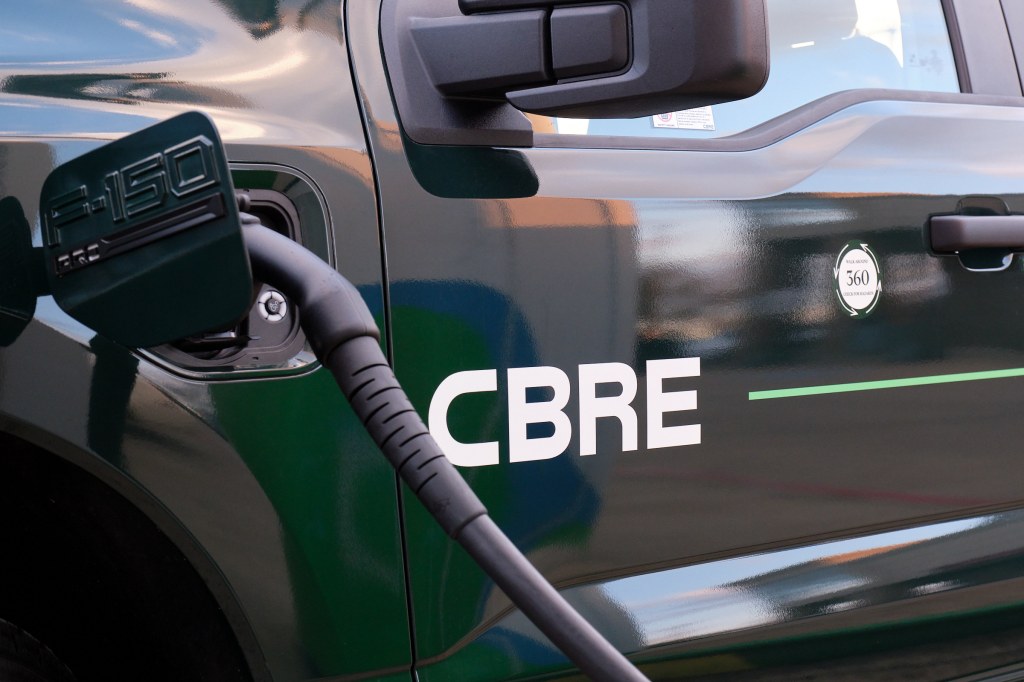Are EV Charging Stations Worth It?
Getting ready for this change is an ongoing mission, CRE executives say.

Three things need to happen before more consumers get on board with electric vehicles: faster charging time (under 20 minutes), a 350-mile plus driving range and a lower purchase price. Despite these obstacles and other hiccups along the way—like how this year’s elections could shape policy—EVs are here to stay.
According to J.P. Morgan, just under 1 million vehicles, or 1 percent of global auto sales, came from plug-in electric vehicles in 2016. By next year, EVs and hybrid electric vehicles are estimated to account for some 30 percent of all sales. This is putting pressure on owners of office and retail properties, who might need to invest now if they want to be part of tomorrow’s infrastructure.
Shop—and work—while you charge

“As an owner of an EV. I may be prejudiced. However, I do think progressive landlords should take advantage (of the opportunity) in the competitive leasing market to supply EV charging stations on their properties,” said Jeff Chain, principal with Millennium Commercial Properties.
“EVs are here to stay, and you see more and more every month on the streets and in our neighborhoods. Ease and convenience could make the difference from a possible tenant selecting your property over a non-EV property,” added Chain.
Millennium Commercial Properties is taking over the management of several large office buildings in the northwest part of Las Vegas. Chain has already discussed with the owner about putting in EV stations.
READ ALSO: EV Boom Reshapes US Industrial Landscape
Chain has developed more than 1 million square feet of office space in Las Vegas, but that was pre-EV. “If I were to do another ground-up or remodel, I would definitely include EVs,” he mentioned. The ability to sit in the office instead of a parking lot to charge would be great. Retail centers in Las Vegas have also discovered EV charging brings customers to their centers. While the car is charging, they are shopping.
Minimizing risk when deploying EV chargers
“Most of our REITs and investors—the landlords at commercial properties—are heavily focused on what is the right ownership structure of EV infrastructure,” said Jim Hurless, global real estate leader for CBRE’s EV business. “Should an office or landlord buy the hardware, the software and operate the network themselves—or should they pull in a third-party operator? It all comes down to capital.”

Some operators are opting to have a third-party operator come in and deploy their own network at no capital expense to the landlord in lieu of a form of revenue share. “There’s a lot of different models, but largely landlords are looking for zero capital and to minimize the amount of risk so that they’re not depending on utilization of those chargers to make back that investment,” added Hurless.
READ ALSO: EV Battery Quest Super-Charges Demand for Sites, Facilities
Nobody is ignoring the EV conversation, especially on the developer side, according to Hurless. Several states are requiring minimum EV deployments as soon as development starts on a new building, or when a parking lot is renovated. In some parts of California, 10 percent of all parking stalls must be pre-prepped or have operating EV infrastructure deployed along with the new construction. San Francisco has a 20 percent mandate in the municipality. In New York and Detroit, 5 percent of parking stalls have to be electrified.
According to Hurless, regardless of the mandates, there’s no shortage of private capital funding the deployment and growth of EV charging. EV vehicles are going to be the way of the future and that infrastructure will need to be in place. “The capital lending institutions and the equity firms are definitely putting money into this space,” he noted.
EV chargers as competitive amenity
Landlords should be considering investments in EV charging stations as part of their overall tenant attraction strategy. “In most cases, low-cost Level 2 chargers will suffice. Consider that, even as growth in EV sales has slowed in an era of high interest rates, they were still up 40 percent year-over-year,” pointed out Jeff Gerwig, national director of engineering and ESG strategy for Colliers.
More and more tenant employees will be driving EVs, and about one-third of them don’t have easy access to home charging, noted Gerwig. “They will rely on public charging, and there is nowhere more convenient than the workplace. It’s a location where the car will be parked for 8+ hours. Property owners rarely would need to invest in DC fast charging stations. Regular Level 2 chargers, which are relatively inexpensive, will usually do the job.”
Mandates will be important, but the bottom line is that tenants will also be demanding EV charging as a part of their ability to attract employee talent.
“Being ahead of the curve also means landlords can take advantage of EV infrastructure incentives offered through the Inflation Reduction Act, which will sunset in the next eight to 10 years,” Gerwig pointed out.







You must be logged in to post a comment.